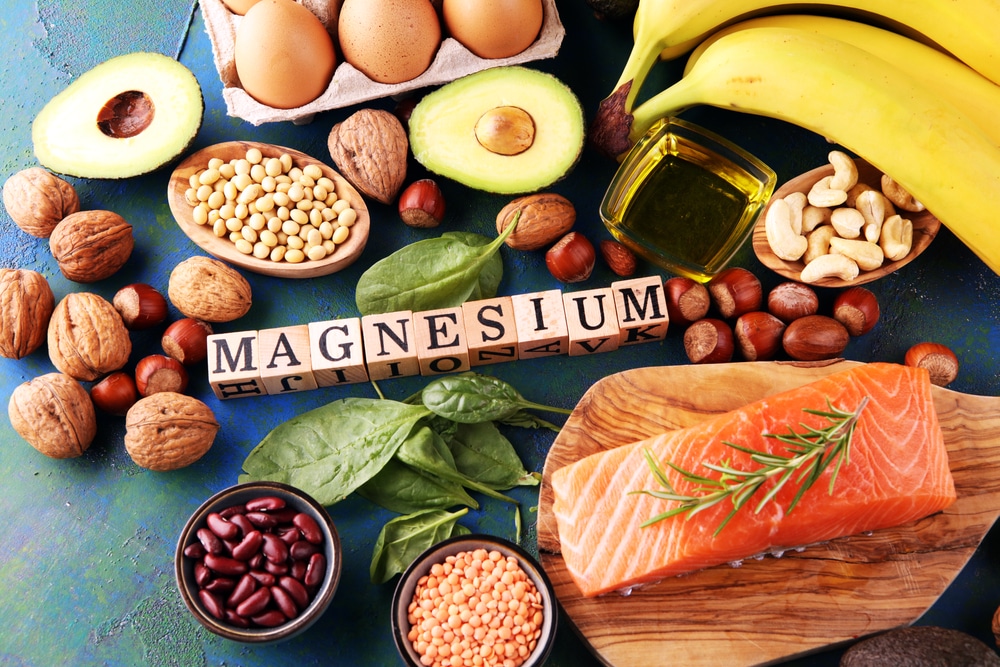Magnesium, an essential mineral often hailed as the “Master Mineral,” plays a pivotal role in over 300 biochemical reactions within our body. It’s that silent orchestrator ensuring everything from our energy production to muscle movement functions smoothly. Yet, as you stroll down the supplement aisle, you might find yourself bewildered by the array of magnesium types, each with its own unique promises. Ten, to be precise. But how do you discern which one is the golden ticket for your health needs?
10 Types of Magnesium & Their Benefits Discussed
Let’s demystify the top 10 forms of magnesium and find out which ones truly deserves a spot in your daily regimen.
1. Magnesium Citrate
Magnesium citrate is a popular form of magnesium. It is a form of magnesium that’s bound with citric acid. A study suggests that this type is among the most bioavailable forms of magnesium, meaning it’s more easily absorbed in your digestive tract than other forms. [1]
It is commonly ingested orally for the purpose of restoring depleted magnesium levels. At higher dosages, it is occasionally employed to address constipation owing to its natural laxative properties. Some have marketed it as a soothing agent to alleviate symptoms linked to depression and anxiety, though further investigation is necessary to substantiate these applications. [2]
2. Magnesium Oxide
Magnesium oxide combines magnesium and oxygen. Naturally, it takes the form of a white, powdery substance and can be found in powder or capsule form for sale. This type isn’t typically used to prevent or treat magnesium deficiencies, as some studies report that it’s poorly absorbed by your digestive tract. [3]
Instead, people use it more frequently to relieve uncomfortable digestive symptoms, such as heartburn, indigestion, and constipation. Some may also use it to treat and prevent migraine episodes, but more research is needed to confirm that magnesium deficiency can contribute to migraine attacks.
Given that the body doesn’t absorb it well, it isn’t a good choice for those who need to raise their magnesium levels. You may want to consult with a doctor before taking magnesium oxide.
3. Magnesium Chloride
Magnesium chloride is a magnesium salt that includes chlorine — an unstable element that binds well with other elements, including sodium and magnesium, to form salts. It’s well absorbed in your digestive tract, making it a great multi-purpose supplement. You can use it to treat low magnesium levels. [4]
People take magnesium chloride most frequently in capsule or tablet form, but it may also be an ingredient in topical products like lotions and ointments. Although people use these skin creams to soothe and relax sore muscles, little scientific evidence links them to improved magnesium levels.
People can also take magnesium chloride internally, as the intestines absorb it well. However, as with some other types of magnesium, it may cause digestive side effects.
4. Magnesium Lactate
Magnesium lactate is the salt formed when magnesium binds with lactic acid.
This acid is produced by your muscle and blood cells. Magnesium lactate is manufactured as a preservative and flavoring agent and is often used as a food additive to regulate acidity and fortify foods and beverages. It’s less popular as an over-the-counter dietary supplement. [5]
Magnesium lactate may benefit people who take large doses of magnesium regularly because it’s easily absorbed by the digestive tract and so gentler. Other studies likewise reveal that this form may help treat stress and anxiety, but more research is needed.
5. Magnesium Malate
This type of magnesium is a compound of magnesium and malic acid. Research suggests that magnesium malate is very well absorbed in your digestive tract, making it a great option for replenishing your magnesium levels, gentler on your system, and may have a less laxative effect than other types. [6]
Magnesium malate is sometimes used to address symptoms of fibromyalgia and chronic fatigue syndrome. Although a few studies indicate potential advantages, there’s a need for deeper research to confirm these findings. [7]
6. Magnesium Taurate
Magnesium taurate contains the amino acid taurine. Adequate intakes of taurine and magnesium may promote healthy blood sugar levels. It may help guard against obesity, high cholesterol, and high blood pressure. [8]
A study reports that magnesium taurate reduced high blood pressure and heart damage in rats that had taken a toxic substance. However, people should not use magnesium supplements as a treatment for cardiovascular conditions until more research confirms it. [9]
7. Magnesium L-threonate
Magnesium L-threonate results from the combination of magnesium and threonic acid, a water-soluble byproduct of vitamin C metabolism. This variant is readily absorbed by the body.
Clinical research suggests that using magnesium L-threonate to boost magnesium levels in the brain might enhance learning and memory capabilities. Consequently, it’s frequently sought after for its potential neurological advantages and could aid in addressing conditions like depression, Alzheimer’s disease, and memory decline associated with aging. [10,11]
8. Magnesium Sulfate
Magnesium sulfate emerges from the union of magnesium, sulfur, and oxygen and is popularly recognized as Epsom salt. While it’s an option for constipation relief when ingested in capsule form or dissolved in water, its taste is far from appealing. Overuse or frequent consumption can pose risks. [12]
Optimal magnesium levels contribute to muscle relaxation and stress alleviation. Though concrete evidence is limited regarding its skin absorption, many individuals infuse their baths or foot soaks with Epsom salts, seeking relief from sore muscles. [13]
9. Magnesium Glycinate
Magnesium glycinate is a fusion of elemental magnesium and the amino acid glycine, a foundational block for protein synthesis present in protein-dense foods like fish, meat, dairy, and legumes.
While preliminary animal studies indicate that glycine alone might enhance sleep quality and address certain inflammatory ailments, including heart disease and diabetes, comprehensive research is still underway. [14]
Known for its soothing qualities, magnesium glycinate is believed to alleviate a range of mental health challenges, spanning anxiety, depression, stress, and insomnia. [15]
10. Magnesium Orotate
Magnesium orotate combines magnesium with orotic acid, a crucial compound in the creation of your body’s genetic material, including DNA.
Research underscores the potential benefits of magnesium orotate for heart health, given orotic acid’s unique contribution to energy production within the heart and vascular tissues. This characteristic makes it popular among competitive athletes, fitness aficionados, and potentially those contending with heart-related ailments. [16]
Mg-Orotate tablets are typically prescribed to address magnesium deficiencies in the bloodstream. Additionally, certain brands cater to alleviating symptoms associated with excessive stomach acid, such as stomach discomfort, heartburn, and acid indigestion.

What’s the Best Form of Magnesium?
The truth is, all forms of magnesium have their merits. However, the “best” one isn’t a one-size-fits-all answer — it hinges on your individual health goals, needs, and conditions. Think of magnesium types as tools in a toolkit. Each has its specific application where it shines brightest:
- For General Health & Well-being: Magnesium citrate or magnesium glycinate are easily absorbed and gentle on the stomach, making them popular choices for general supplementation.
- For Brain Health & Cognitive Function: Magnesium L-threonate is favored due to its ability to increase magnesium levels in the brain, potentially supporting memory and learning.
- For Muscle Relaxation & Stress Relief: Magnesium sulfate, known commonly as Epsom salt, can be added to baths for muscle relaxation, though its oral consumption is limited due to taste and potential overuse risks.
- For Heart Health & Athletic Performance: Magnesium orotate is preferred because of its potential cardiovascular benefits.
- For Sleep & Mental Well-being: Magnesium glycinate possesses calming properties and may help with conditions like anxiety, depression, and insomnia.
- For Constipation: Magnesium citrate has a laxative effect and can aid in bowel movements.
- For Specific Conditions: Some forms, like magnesium malate, might be recommended for conditions like fibromyalgia, but always consult a doctor for such specific recommendations.
Remember, individual reactions to different magnesium forms can vary. It’s crucial to consult with a healthcare professional to determine the most appropriate type and dosage for your unique needs.
How Much Magnesium Should You Take?
Magnesium is an essential mineral vital for numerous bodily functions. However, the optimal amount you should consume can vary based on factors like age, gender, and specific health conditions. [17]
The Recommended Dietary Allowances (RDAs) for magnesium are:
- Infants to 6 months: 30 mg
- 7-12 months: 75 mg
- 1-3 years: 80 mg
- 4-8 years: 130 mg
- 9-13 years: 240 mg
- 14-18 years: Men – 410 mg / Women- 360 mg
- 19-30 years: Men – 400 mg / Women – 310 mg
- 31 years and older: Men – 420 mg / Women – 320 mg
- Pregnant women: 350-400 mg
- Breastfeeding women: 310-360 mg
It’s important to note that while magnesium is available in various foods like green leafy vegetables, nuts, and whole grains, some individuals might still need to take supplements due to dietary restrictions or health conditions. Always consult a healthcare professional before starting any supplements, as taking excessive magnesium can lead to side effects such as diarrhea, nausea, and cramps. Remember, balance is the key!

Magnesium-Rich Foods to Add to Your Diet
Ensuring an adequate intake of magnesium is essential for maintaining overall health and well-being. Incorporating magnesium-rich foods into your diet can not only help you meet your nutritional needs but also provide a wide range of additional health benefits.
1. Leafy Greens: Leafy green vegetables like spinach, kale, Swiss chard, and collard greens are packed with this essential mineral. Whether you consume them in salads, smoothies, or cooked dishes, adding more leafy greens to your diet is a nutritious way to increase your magnesium intake.
2. Nuts and Seeds: Almonds, cashews, peanuts, pumpkin seeds, and sunflower seeds are all rich in magnesium. Snacking on nuts or incorporating them into your meals and desserts can be a tasty way to boost your magnesium levels.
3. Whole Grains: Whole grains like brown rice, quinoa, and oats are not only excellent sources of dietary fiber but also provide a healthy dose of magnesium. Consider swapping refined grains for their whole-grain counterparts to enhance your magnesium intake while benefiting from added nutrients and sustained energy.
4. Legumes: Chickpeas, black beans, and lentils can be incorporated into various dishes, such as soups, stews, and salads, to help you meet your magnesium requirements.
5. Seafood: Fatty fish like salmon and mackerel not only offer heart-healthy omega-3 fatty acids but are also good sources of magnesium. Including fish in your diet a few times a week can provide you with both essential nutrients and a delicious meal.
6. Avocado: Avocado is not only creamy and delicious but also a fantastic source of magnesium. Whether you spread it on toast, add it to salads, or blend it into a smoothie, avocado can be a versatile and nutritious addition to your diet.
7. Bananas: Bananas are a convenient and portable source of magnesium. They are also rich in potassium, making them an excellent choice for post-workout snacks or quick energy boosts.
8. Dark Chocolate: Good news for chocolate lovers: dark chocolate (with at least 70% cocoa content) contains magnesium. While you should enjoy it in moderation due to its calorie content, a small piece of high-quality dark chocolate can satisfy your sweet tooth while providing some magnesium.
9. Dairy Products: If you consume dairy, yogurt and milk are good sources of magnesium. Greek yogurt, in particular, is rich in this mineral and can be a healthy addition to your diet.
My Personal RX for Magnesium Mastery
Throughout my medical journey, I’ve been fascinated by the myriad of roles magnesium plays in our health. But as we’ve already seen, not all magnesiums are created equal. Each type holds its own unique benefits, ensuring our body functions harmoniously. Here’s my personalized prescription for mastering the benefits of this master mineral.
- Get Your Magnesium Boost: Tailored for those seeking optimal health, my Magnesium Essentials supplements ensure you’re getting an adequate dose of this wonder mineral every day. Perfect for filling those nutritional gaps.
- Pair with Vitamin D: Vitamin D helps optimize magnesium absorption. Consider sun exposure or vitamin D-rich foods to ensure efficient uptake.
- Mind Your Dosage: While magnesium is beneficial, more isn’t always better. It’s crucial to find a balance that suits your specific needs. Consultation is key!
- Beware of Caffeine: Excessive coffee or tea can decrease magnesium levels. If you’re a caffeine lover, balance your intake and consider foods or supplements to replenish your magnesium.
- Delve Deeper with my free Protocol: Discover more about the integral role of various nutrients and minerals like magnesium in our health through my comprehensive Protocol for Optimizing Your Health and Wellbeing. Dive into details and get the most out of your nutrition.
If you have specific dietary restrictions or health concerns, consider consulting a healthcare professional or nutritionist for personalized advice on incorporating magnesium-rich foods into your diet.
Sources:
- Werner, T., Kolísek, M., Vormann, J., Pilchová, I., Grendár, M., Struhárňanská, E., & Cibulka, M. (2019). Assessment of bioavailability of Mg from Mg citrate and Mg oxide by measuring urinary excretion in Mg-saturated subjects. PubMed, 32(3), 63–71. https://doi.org/10.1684/mrh.2019.0457
- Mg citrate found more bioavailable than other Mg preparations in a randomised, double-blind study. (2003, September 1). PubMed. https://pubmed.ncbi.nlm.nih.gov/14596323/
- PubChem. (n.d.). Magnesium oxide. PubChem. https://pubchem.ncbi.nlm.nih.gov/compound/Magnesium-Oxide
- Schuchardt, J. P., & Hahn, A. (2017). Intestinal Absorption and Factors Influencing Bioavailability of Magnesium- An Update. Current Nutrition & Food Science, 13(4). https://doi.org/10.2174/1573401313666170427162740
- Magnesium Lactate Market on the Rise and Predicted to Cross US$ 44.80 Billion by 2033, with a steady growth rate of 8.2%: Persistence Market Research. https://finance.yahoo.com/news/magnesium-lactate-market-rise-predicted-182000269.html
- Uysal, N., Kızıldağ, S., Yüce, Z., Güvendi, G., Kandiş, S., Koç, B., Karakiliç, A., Çamsari, U. M., & Ateş, M. (2018). Timeline (Bioavailability) of magnesium compounds in hours: Which magnesium compound works best? Biological Trace Element Research, 187(1), 128–136. https://doi.org/10.1007/s12011-018-1351-9
- Boulis, M., Boulis, M., & Clauw, D. J. (2021). Magnesium and Fibromyalgia: A literature review. Journal of Primary Care & Community Health, 12, 215013272110384. https://doi.org/10.1177/21501327211038433
- Şak, D., Erdenen, F., Müderrisoğlu, C., Altunoğlu, E., Sözer, V., Güngel, H., Güler, P. A., Şak, T., & Uzun, H. (2019). The Relationship between Plasma Taurine Levels and Diabetic Complications in Patients with Type 2 Diabetes Mellitus. Biomolecules, 9(3), 96. https://doi.org/10.3390/biom9030096
- Shrivastava, P., Choudhary, R., Nirmalkar, U., Singh, A., Shree, J., Vishwakarma, P. K., & Bodakhe, S. H. (2019). Magnesium taurate attenuates progression of hypertension and cardiotoxicity against cadmium chloride-induced hypertensive albino rats. Journal of Traditional and Complementary Medicine, 9(2), 119–123. https://doi.org/10.1016/j.jtcme.2017.06.010
- Shen, Y., Dai, L., Tian, H., Xu, R., Li, F., Li, Z., Zhou, J., Wang, L., Dong, J., & Sun, L. (2019). <p>Treatment Of Magnesium-L-Threonate Elevates The Magnesium Level In The Cerebrospinal Fluid And Attenuates Motor Deficits And Dopamine Neuron Loss In A Mouse Model Of Parkinson’s disease</p> Neuropsychiatric Disease and Treatment, Volume 15, 3143–3153. https://doi.org/10.2147/ndt.s230688
- Zhang, C., Hu, Q., Li, S., Dai, F., Wen, Q., Hewlings, S., Yan, T., & Wang, Y. (2022). A Magtein®, Magnesium L-Threonate, -Based formula improves brain cognitive functions in healthy Chinese adults. Nutrients, 14(24), 5235. https://doi.org/10.3390/nu14245235
- Hicks, M. A. (2023, May 1). Magnesium sulfate. StatPearls – NCBI Bookshelf. https://www.ncbi.nlm.nih.gov/books/NBK554553/
- Gröber, U., Werner, T., Vormann, J., & Kisters, K. (2017). Myth or Reality—Transdermal magnesium? Nutrients, 9(8), 813. https://doi.org/10.3390/nu9080813
- Razak, M. A., Begum, P. S., Viswanath, B., & Rajagopal, S. (2017). Multifarious Beneficial effect of nonessential amino acid, glycine: a review. Oxidative Medicine and Cellular Longevity, 2017, 1–8. https://doi.org/10.1155/2017/1716701
- Eby, G. A., & Eby, K. L. (2006). Rapid recovery from major depression using magnesium treatment. Medical Hypotheses, 67(2), 362–370. https://doi.org/10.1016/j.mehy.2006.01.047
- Șchiopu, C. G., Ștefănescu, G., Diaconescu, S., Bălan, G. G., Gimiga, N., Rusu, E., Moldovan, C., Popa, B., Tătăranu, E., Olteanu, A. V., Boloș, A., & Ștefănescu, C. (2022). Magnesium Orotate and the Microbiome–Gut–Brain Axis Modulation: New Approaches in Psychological Comorbidities of Gastrointestinal Functional Disorders. Nutrients, 14(8), 1567. https://doi.org/10.3390/nu14081567
- Office of Dietary Supplements – magnesium. (n.d.). https://ods.od.nih.gov/factsheets/Magnesium-HealthProfessional/





















